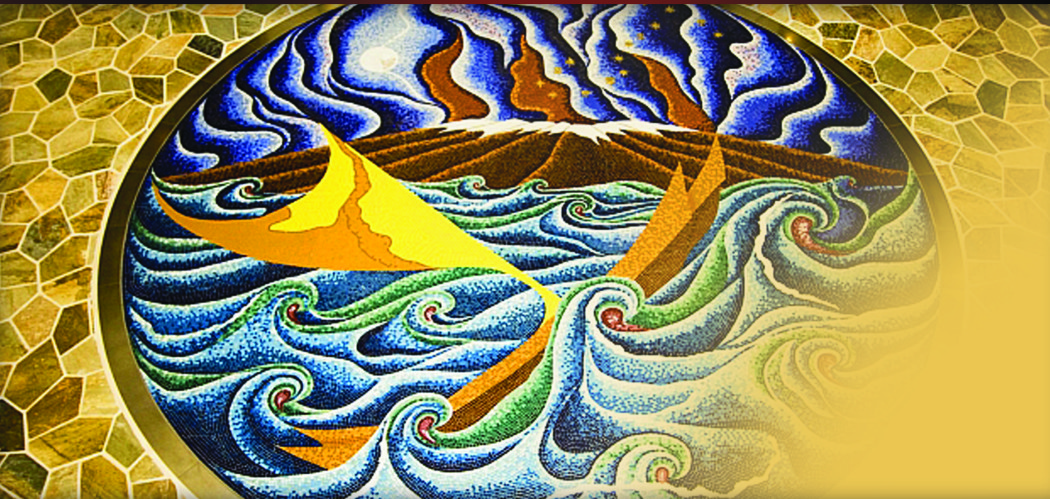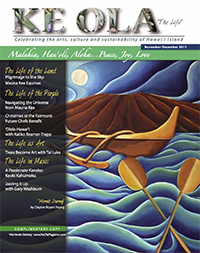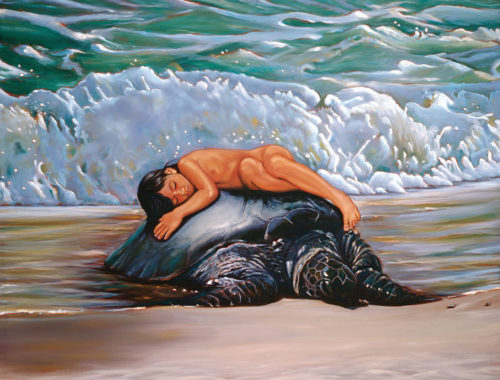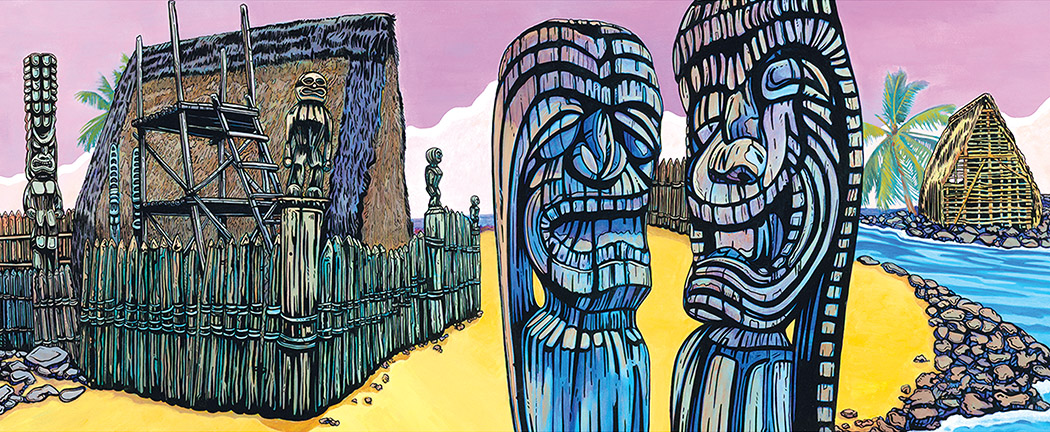
The Art of Clayton Bryant Young: Former Green Beret Creates Paintings with Spirit
 By Karen Valentine
By Karen Valentine
When you consider that artist Clayton Bryant Young was once a Green Beret, spending 11 years in the U.S. Army, you might wonder how being a soldier has affected his art and his art career. The luscious, undulating style of painting he developed while at the University of North Texas School of Fine Arts, compliments of the G.I. Bill, is bold and action-packed. That might be a clue.
Young brought his family to Hawai‘i Island in 2001. The energy of the island added a new dimension to the size and emotion of his paintings—his abstract, expressionistic designs blended naturally with the dynamic spirit of Hawai‘i and the colors came alive.
“We went to Hawai‘i to spend the rest of our lives—have our kids in a healthier environment with traditional values. Like others, we sold everything, I quit my job, and we built a life we loved in Hawai‘i,” said Young, whose works are now part of the architecture of several local, public buildings.
As a kid, Clayton loved to paint and play around with art. “Like many artistically inclined kids, my parents indulged my creative nature until I became a teenager. Then I was expected to seek out a ‘real career’ that I could make a living at.” Young didn’t let that stop him, though. “After 11 years in the Army, I had an opportunity to return to college on the G.I. Bill,” he said. “It was a chance to start over and pursue my passion. It was a huge gamble—I was a single parent returning to college.”
Fearlessly he forged ahead and, since then, Young has also applied the Green-Beret spirit to getting his art out in front of the public eye. The way he charged boldly into the Hawai‘i Island art market in just two years is a case in point.

“It’s true that making a career of art takes work—not just honing your skills and learning art history, but learning about business, marketing, psychology, buying and selling. You have to set about finding and developing the people that want to own what you create. It involves a lot of donating, promoting and communication.”
In August 2003, Clayton’s multi-canvas and textural version of “Pele” was chosen for exhibition at Hawai‘i Volcanoes National Park. Clayton has made significant contributions to the Big Island community with his large-format painting located at the Hilo Medical Center and four permanently displayed in the Hawai‘i County Annex Building in Hilo. One of Young’s paintings was redesigned as a giant, glass floor mosaic at the entrance to the $28 million ‘Imiloa Astronomy Center, a beautiful and dynamic museum dedicated to the science and Hawaiian culture on Mauna Kea.
Also in 2003, the Wailoa Art Center in Hilo hosted Young’s first Hawai‘i show, “One Paradise.” It was comprised of 11 pieces that he designed specifically for that space. “The works were about my emotional and spiritual response to the Big Island of Hawai‘i and the Hawaiian culture. The show was received well, it led to several commissions and, most important, I felt a lot of aloha from Hawaiians and the community.”
At the University of North Texas, Young says, he had experimented with many forms of art before honing in on his signature painting style. “In my last year, I concentrated on large-format oil paintings that were strictly about shape, color and texture, as it sets up emotional content. My work is derived from colorful puzzles from my childhood, stained glass, and the influence of artists like Georgia O’Keefe, Salvador Dali, Van Gogh and Picasso. I call it hard-edged abstraction. Determining the subject, then reducing to the important elements, I intuitively break up the shapes and then paint each section from light to dark.”
His monochromatic painting, “Wallflowers II,” for example, uses dramatic light and shadow to represent the forms in foliage without the vibrant colors that one would expect. It invites the viewer to appreciate the sometimes-overlooked flowers and plants. “Life Under the Sea” reminds you of a child’s game of find-the-fish among the abstract forms, illustrating the interplay of sea life in their underwater world.
A Waking Dream
Preparing for his one-man show, the malihini reflected on his creative approach. Adapting his style to the spirit and culture of Hawai‘i was a surrealistic process. “I didn’t grow up in Hawai‘i. I asked myself, ‘Would my artistic response to Hawai‘i be embraced by a culture intimate with the ideas that I was compelled to express?’ It took me six months and a waking dream to put paint to canvas. We lived in the rainforest in Puna. I had all of these canvasses out in the studio ready to paint. I was down to six months before my one-man show. I woke up one night about 2 a.m., with a vision of a double-hulled canoe leaping straight up in a stormy sea. I ran outside and sketched what I had seen, adding in a star constellation—Scorpio—not knowing that it was called ‘Maui’s Fishhook,’ nor how important it was to Hawaiian
celestial navigation.”
That dream image became “The Navigator,” a dramatic depiction in blues, greens, purples and gold, of a voyaging canoe in wind-tossed waters.
“The next day I set up three easels and didn’t stop painting for six months. I was about halfway through the series when my wife Amber came outside to tell me the news that the Volcano Art Center was asking for art submissions. In four days I finished ‘Pele and Lehua.’ I entered the contest along with 240 other artists. It was totally different—made of two canvasses and a textured Plexiglas relief over the bottom section with the volcano representing Pele’s hair. It made the top 60 and was displayed at Volcano House. It didn’t win, but my piece found a good home on the Big Island,” he relates.
After his show, the artist looked for “a place where I could have my other work on display for the general public. I saw a space at the County Annex in Hilo and decided to donate four pieces to the County. I went before the County Council to offer the pieces, and they graciously accepted. The next week we had the unveiling with my family and Mayor Kim present. It was a really great honor to have my work up for everyone to experience. I even had art students from local schools write to me and ask me to meet their classes at the site for lecture and discussion.”
Clayton’s commission to create a piece of art for the new ‘Imiloa Astronomy Center came after he submitted one of the versions of “The Navigator” painting, which included a volcanic mountain in the background.
“All of my commissions have been based on existing work, including the giant glass floor mosaic in the entrance to the ‘Imiloa Center in Hilo,” he said. “When I am moved to create around a particular subject or idea, it is usually too big to be restricted to one canvas, so I usually create a series.”
When the ‘Imiloa Center planners called for artists’ concepts for the building, Young says, “My wife, Amber, found an article interviewing Dr. Marlene Hapai, then the new director of the soon-to-be ‘Imiloa Astronomy Center. Amber pointed out that my work, ‘The Navigator’ depicted exactly what the Center was about—a bridge between astronomy and Hawaiian culture, celebrating the first astronomers—Hawaiian navigators. Having seen the ‘The Navigator’ in an art gallery in Hilo, Dr. Hapai invited me to submit art and bid for the entrance floor mosaic. I won against 30 submissions.”
Synchronicity continued to follow the process all along the way from dream to installation. “It was a dream come true, literally,” Clayton says. The commission required a circular image. “After painting a new circular version of ‘The Navigator,’ [including Mauna Kea in the background and titled “Voyage of the Navigator”] a digital image was sent to a tile company in Italy where they cut, partially-assembled, and shipped the 14-foot diameter mosaic with 144,000 glass tiles to Hawai‘i. The floor mosaic was then laid with a titanium ring around the edge. What I didn’t know was that the architect designed the entrance with a circular skylight. It was also 14 feet in diameter! We later discovered that we could teach people about the sun’s annual transit of the sky as the sun would align on or about May 20 with the skylight and mosaic, filling the disc with sunlight (provided the weather cooperated.)”
The mosaic was unveiled during a gala opening celebration, and framed copies of “Voyage of the Navigator” were given to Senator Daniel Inouye, NASA Space Center, ‘Imiloa benefactor Dr. Earl Bakken and the director of Subaru Telescope.
“The other part of my dream come true,” says Clayton, “is I was hired to be the Visitor Services Supervisor at ‘Imiloa. It was one of the most rewarding jobs I’ve ever had: to share my art and its relationship to the Center with thousands of guests from all over the world, and to hopefully inspire the visiting school children of Hawai‘i and Japan.”
Clayton and his wife have two teenaged daughters who he says have great promise as prodigies in other creative fields. One is a screenwriter/filmmaker and the other a ballerina in a dance company.
“What I’ve learned and now apply to raising my own children,” Clayton says, “is that what’s really important is fostering that natural gift—the one that drives our passion.”
This philosophy led the couple to make the difficult decision to return to the Mainland for their daughters’ educations.
“We only left our home in Hawai‘i out of necessity. My oldest daughter was 15, and being mentored long distance by a veteran screenwriter. My youngest daughter was in ballet, and very promising. We were too far away from any schools or companies where she could progress. So we made the heart-wrenching decision to move to Southern California until such time as the girls’ careers were self-sustaining. They are building their own production company and have garnered attention from veteran writers, producers, and actors with their projects. They are currently producing an original fantasy action/adventure web series due to come out next year.”
The artist hopes to return to Hawai‘i and continue making art, he says. “My art work has never been as inspired as it was in Hawai‘i. I have much more to do. We look forward to someday returning to our home, our friends, and artistic endeavors. ❖
Young’s artworks are in private collections across the continental United States and in Hawai‘i. Several of his paintings are now available as limited edition giclée prints. They may be viewed and purchased online at claytonyoungstudios.com.
Contact writer Karen Valentine at karen@keolamagazine.com.


